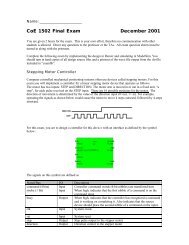Discovering critical residues in glutathione reductase - Gentoo
Discovering critical residues in glutathione reductase - Gentoo
Discovering critical residues in glutathione reductase - Gentoo
Create successful ePaper yourself
Turn your PDF publications into a flip-book with our unique Google optimized e-Paper software.
Figure 8: Phe254, a surface hydrophobic residue. See text for discussion.<br />
Mov<strong>in</strong>g away from <strong>residues</strong> <strong>in</strong>volved <strong>in</strong> the active site, one can exam<strong>in</strong>e<br />
where hydrophobic conserved <strong>residues</strong> fall with<strong>in</strong> the prote<strong>in</strong>. As Kendrew's<br />
rules say, (1) Hydrophilic <strong>residues</strong> are on the surface, (2) Hydrophobic <strong>residues</strong><br />
are <strong>in</strong> the core, and (3) Any violation of the above rules <strong>in</strong>dicates function.<br />
Follow<strong>in</strong>g this, there is an odd occurrence of a 100% conserved hydrophobic<br />
residue on the surface of the prote<strong>in</strong> away from the active site, Phe354 (Figure<br />
8). As this is grossly energetically unfavorable, it must serve some purpose,<br />
although what purpose exactly rema<strong>in</strong>s unclear. If one looks at nearby nonhydrophobic<br />
conserved <strong>residues</strong>, one f<strong>in</strong>ds Ala39 and Asp22, both about 4-5A<br />
from the phenylalan<strong>in</strong>e r<strong>in</strong>g. This suggests some sort of b<strong>in</strong>d<strong>in</strong>g site for an<br />
<strong>in</strong>hibitor or activator, because no structural stability is possible from it, and the
















